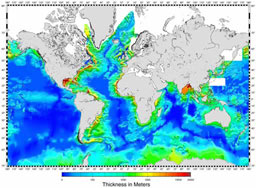|
World Data Service for Geophysics
Total Sediment Thickness of the World's Oceans and Marginal Seas, Version 1
Version 1 is deprecated, the current sediment thickness model is Version 2
A digital total-sediment-thickness database for the world's oceans and marginal seas has been compiled by the
NOAA National Geophysical Data Center (NGDC) (now the National Centers for Environmental Information (NCEI)). The data were gridded with a grid spacing of 5 arc-minutes by 5
arc-minutes. Sediment-thickness data were compiled from three principle sources: (i) previously published
isopach maps including Ludwig and Houtz [1979], Matthias et al. [1988], Divins and Rabinowitz [1990], Hayes and
LaBrecque [1991], and Divins [2003]; (ii) ocean drilling results, both from the Ocean Drilling Program (ODP) and the
Deep Sea Drilling Project (DSDP); and (iii) seismic reflection profiles archived here as well as seismic data and
isopach maps available as part of the IOC's International Geological-Geophysical Atlas of the Pacific Ocean [Udinstev, 2003].
The distribution of sediments in the oceans is controlled by five primary factors:
- Age of the underlying crust
- Tectonic history of the ocean crust
- Structural trends in basement
- Nature and location of sediment source, and
- Nature of the sedimentary processes delivering sediments to depocenters
The sediment isopach contour maps for the Pacific were digitized by Greg Cole of Los Alamos National Laboratory,
for the Indian Ocean by Carol Stein of Northwestern University, and the South Atlantic and Southern Ocean by
Dennis Hayes of Lamont-Doherty Earth Observatory. The digitized data were then gridded at NGDC (now NCEI) using the algorithm
for "Gridding with Continuous Curvature Splines in Tension" of Smith and Wessel [1990].
The data values are in meters and represent the depth to acoustic basement. It should be noted that acoustic
basement may not actually represent the base of the sediments. These data are intended to provide a minimum
value for the thickness of the sediment in a particular geographic region.
How to Cite These Data:
Divins, D.L., Total Sediment Thickness of the World's Oceans & Marginal Seas, NOAA National Geophysical Data Center, Boulder, CO, 2003.
Other References:
Divins, D.L., Thickness of Sedimentary Cover in the Eastern Pacific Ocean, in International Geological-Geophysical
Atlas of the Pacific Ocean, edited by G.B. Udintsev, pp. 120, 126-127, 130, Intergovernmental Oceanographic Commission,
Moscow-Saint Petersburg, 2003.
Divins, D.L., and P.D. Rabinowitz, Thickness of Sedimentary Cover for the South Atlantic, in International
Geological-Geophysical Atlas of the Atlantic Ocean, edited by G.B. Udintsev, pp. 126-127, Intergovernmental
Oceanographic Commission, Moscow, 1990.
Hayes, D.E., and J.L. LaBrecque, Sediment Isopachs: Circum-Antarctic to 30S, in Marine Geological and Geophysical
Atlas of the Circum-Antarctic to 30S, edited by D.E. Hayes, pp. 29-33, American Geophys. Union, Washington, D.C., 1991.
Ludwig, W.J., and R.E. Houtz, Isopach Map of the Sediments in the Pacific Ocean Basin, color map with text, Am. Assoc. Pet.
Geol., Tulsa, OK., 1979.
Matthias, P.K., P.D. Rabinowitz, and N. Dipiazza, Sediment Thickness map of the Indian Ocean, Map 505, Am. Assoc. Pet. Geol.,
Tulsa, OK., 1988.
Smith, W.H.F., and P. Wessel, Gridding with Continuous Curvature Splines in Tension, Geophysics, 55, 1990.
Tucholke, B.E., and E. Uchupi, Thickness of Sedimentary Cover for the North Atlantic, in International
Geological-Geophysical Atlas of the Atlantic Ocean, edited by G.B. Udintsev, pp. 122-125, Intergovernmental Oceanographic Commission, Moscow, 1990.
Udinstev, G.B. (editor), International Geological-Geophysical Atlas of the Pacific Ocean, 192 p., Intergovernmental
Oceanographic Commission, Moscow-Saint Petersburg, 2003.
|
|

